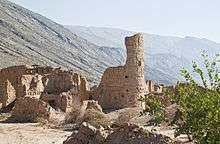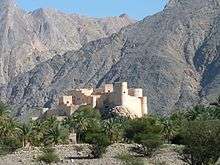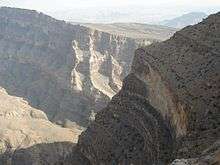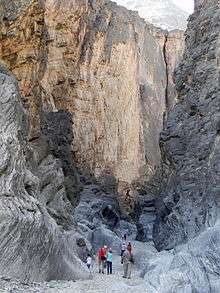Hajar Mountains
The Hajar Mountains are a range in Northern Oman stretching along the northern coast of Oman, from southwest of Muscat to the United Arab Emirates.
Understand
This dramatic mountain range has a wealth of attractions for the adventurous traveler, including trekking, rock climbing, canyoning, and off-road exploration. In addition to outdoor activities, there are numerous sights of historic, cultural, and geological interest.
Temperatures in the higher elevations tend to be on average 10-15°C cooler than Muscat, and snow, although very rare, is not unknown. In summer the mountains offer a retreat for those looking to escape the heat baking the rest of Oman and the Arabian peninsula.
Get in
From Muscat, Highways 15 and 21 skirt the southern reaches of the range, and Highways 13 and 11 provide access from the north. Travelers from the UAE will arrive via Highway 21.
Get around
It is possible to get a glimpse of some of the mountains' spectacular scenery with just a 2WD, but to really explore a 4WD is essential, as many highlights are otherwise simply inaccessible.
See

.jpg)

- 🌍
Archaeological Sites of Bat, Al-Khutm and Al-Ayn (from Hwy 21, turn north at the petrol station between Nizwa and Ibri, following signs for Amla, Al Ayn, Damm/Dham, and Sint). Three sites of prehistoric settlements and beehive tombs dating from the 3rd millennium BCE, collectively inscribed on the UNESCO World Heritage list. Free.
- 🌍 Bat. This site was excavated in 1976 and includes communal graves, ruins of tower forts, and beehive tombs.
- 🌍 Al-Khutm (2 km west of Bat). This site contains the ruins of a stone tower 20 m in diameter.
- 🌍 Al Ayn (Al Ain). These unexcavated beehive tombs here are in much better condition than those at Bat, with the added dramatic backdrop of Jebel Misht and its 1000m-high cliffs. To access them, take the graded road to the left (just past the junction), and turn right and drive 100 m down the wadi. From here a footpath leads to the tombs.
- 🌍 Wadi Tanuf (Wadi Tanoof) (access from Hwy 21). At the mouth of the wadi are the photogenic ruins of Old Tanuf, which was bombed extensively by the British Royal Air Force during the Jebel Rebellion of 1954-1955. A 4WD track proceeds up the wadi past a recharge dam to the trailheads for W19 and W19a (not waymarked), two excellent hikes through and above neighboring Wadi Qashah.
- 🌍 Al Hoota Cave (Al Hutah, Al Hotta, Al Fallah, Al Falahi), Al Hoota Cave Rd (turn off of Hwy 21 enroute to Al Hamra), ☎ +968 24 498258 (reservations required), e-mail: reserve@alhootacave.com. Sa-Th 09:00-13:00, 14:00-18:00; F 09:00-12:00, 14:00-18:00. A 2.7-km-long living cave network with a large chamber of stalactites and stalagmites, as well as a 800-m-long lake, home to a species of blind fish. There is also a geological museum onsite, as well as a cafe and gift shop. RO 6.5/3 (non-Omani adults/children 6-12), RO 3/1 (Omani adults/children 6-12), free (children under 6).
- 🌍
Misfat al Abriyyin (Misfah) (5km north of Al Hamra). One of the few mountain villages accessible by 2WD on a paved road. The ancient village is in a beautiful setting, with terraced gardens and a falaj irrigation system. The ruined fort of Al Rogan overlooks the village, which is the starting point for the challenging W9 trekking path, connecting with trails W8 and W10h. Donkeys and guides are available for hire here as well.
- 🌍 Misfah Old House, ☎ +968 99 338491, e-mail: bandb.misfah@gmail.com. The only accommodation available in the village, in a traditional Omani house with Omani cuisine cooked by local families. Arrangements for guides can be made here. No internet. RO 25 / singles, RO 50 /doubles, including half-board; cash only.
- 🌍 Al Hamra. Set right at the base of the mountains, this town is notable for a number of Yemeni-style mud-brick buildings, some of which are among the oldest houses in Oman. They are in an older section of the town overlooking the newer town; in recent years many of the older houses have been abandoned as the inhabitants have chosen to move into more modern buildings.
- 🌍 Rustaq Fort. Sa-Th 09:00-16:00; F 08:00-11:00, 14:00-16:00. This restored fortress in the northern foothills has four watch towers and dates to the 13th century. The complex includes a mosque, a former prison and a falaj system. It has been nominated for listing as a UNESCO World Heritage site.
- 🌍 Nakhal Fort, ☎ +968 26 781384. Sa-Th 09:00-16:00; F 08:00-11:00. A restored fortress with a history dating to the pre-Islamic era, scenically situated on a rocky outcropping at the base of the northern Hajar Mountains. The fort houses a museum of historic guns. 500 Bzs (adults).
Itineraries
.jpg)
Jebel Akhdar
Jebel Akhdar ('Green Mountain') is topped by the vast Sayq Plateau (Saiq Plateau), home to traditional mountain villages, fruit orchards, and terraced gardens. Oman's most highly-prized rosewater is produced here, and springtime is particularly beautiful when the fruit trees and rose gardens are all in bloom. This is a cool destination even during the height of summer, and in winter temperatures drop below freezing. It is possible to visit as a very ambitious day trip, but to really appreciate it is best to allow a couple of days. The road is newly paved and in excellent condition but a 4WD is mandatory; travelers without a suitable car will be turned back at the police checkpoint.
- From Highway 15, take the turnoff for Birkat al Mawz. Turn left at the T-junction (following signs for 'Nizwa'), and then follow the signs for 'Al Jabal al Akhdar'. On the right you'll pass 🌍 Bait al Radidah, a thousand-year-old fortress, now fully restored and open to the public.
- A 4WD is required to pass the 🌍 police checkpoint, where you must show your driver's license and car registration. From here you'll need to use low gear.
- 500 m after passing 🌍 Jebel Akhdar Hotel (tel. +968 25 429009), turn left for Sayh Qutnah.
- After 3 km the road forks; take the road to the left and proceed 700 m to 🌍 Sahab Hotel (tel. +968 25 429288). A little way further is the scenic 🌍 Diana's Viewpoint, so named after the Princess of Wales visited in 1990 via helicopter. Some good campsites are nearby, as is the 🌍 Anantara Jabal Al Akhdar Resort (tel. +968 2521 8000, doubles RO 132+).
- The trailhead for 🌍 W18b (Village Walk) begins in the village below the Sahab Hotel. This 2-hour hike passes through the cliff-hugging terraced gardens of Al Ayn, Ash Shirayjah, and Sayq and offers outstanding views of the deep wadis below. If you like you can continue for another 1.5-2 hours along W18a to 🌍 Bani Habib. A short path near the public toilets leads to an abandoned village of mudbrick houses overlooking photogenic plantations.
Jebel Shams

This is Oman's highest peak, with several excellent hiking trails providing spectacular views into Wadi an Nakhur and Wadi Ghul. It is possible to visit as a day trip from Nizwa, but as with Jebel Akhdar it is best to take a couple of days for this excursion.
The road approaching Jebel Shams is not paved for the last 13 km, but is regularly graded and well maintained. It does however occasionally get washed out following heavy rains, after which it becomes impassable without a 4WD. Depending on the weather and the current condition of the road, it may be possible to drive to the end with a 2WD, but those with a rental car should note that driving it off pavement will void your auto insurance.
- From Nizwa, head west on Highway 21 and turn north onto the signposted 🌍 road to Al Hamra. Proceed north for 12 km, and turn left at the 🌍 roundabout. Continue until the 🌍 pavement ends. A little further is a turnoff to the left for 🌍 Sunrise Resort (tel. +968 9266 3837). If you aren't sleeping here, follow the sharp bend of the road to the right. After this point if there have been washouts the road will get quite rough.
- Turn right at the 🌍 sign for Al Khitaym and Al Heil, where the road is again paved. Pass 🌍 Jabal Shams Heights Resort (formerly Jabal Shams Base Camp, tel. +968 92 721 999) to reach the trailhead for 🌍 W4 (trekking path summit of Jebel Shams), a challenging 11-14 hour hike.
- A 🌍 viewpoint offers the first stunning views into Wadi an Nakhur below, and 🌍 Jebel Shams Resort (tel. +968 9938 2639) is a comfortable place to spend the night. Shortly after the resort the pavement ends again; good camping spots as well as some more viewing points are just a bit further up the road.
- The road ends at the tiny goatherders' village of 🌍 Al Khitaym, where local villagers sell woven goat hair rugs and bags. A short distance away is the trailhead for the W6 (Abandoned Village) trekking path, an easy one-hour trek along an ancient donkey path to the abandoned village of 🌍 As Sab (also called Sap Bani Kamis), built directly into the side of the cliff. Notable features of this improbably-located site include mill ruins, cave housing, terraces, and, during the wet season, a waterfall.
Wadi an Nakhur
.jpg)
Wadi an Nakhur is the deepest canyon in the Middle East, and according to some is the world's second-deepest canyon after the Grand Canyon in Arizona. It is sometimes also referred to as Wadi Ghul, although technically Wadi Ghul marks the canyon's mouth, and Wadi an Nakhur is the proper name for the canyon at its widest point.
The canyon is accessed from the road ascending Jebel Shams and turning right near the village of modern Ghul. The trailhead for trekking path W6a begins by the abandoned village of 🌍 old Ghul. The road then passes by the village of Al Hajir, after which point the pavement ends. Here it quickly degrades into a rough track requiring 4WD, but persistence is rewarded with spectacular views of the 1000 m-high cliff faces. After 7 km the road ends at the village of 🌍 An Nakhur.
Wadi Bani Awf to Al Hamra
.jpg)
This is possibly the most scenic route in the Hajar Mountains, and a long drive requiring at least 4 hours and 4WD. Because it passes through some remote areas it is strongly advised to bring a spare tyre and jack, warm clothing, and extra food and water. It is equally scenic to complete this itinerary in reverse.
- From Highway 13, take the signposted road to Wadi Bani Awf. You will pass a very basic 🌍 hotel before reaching a 20 m-high cliff face in 🌍 Wadi Bani Awf, with several good climbing routes.
- In another 7.5 km you will reach a good camping spot, shortly before the village of 🌍 At Tikhah. Proceed straight another 3 km and turn left at the 🌍 junction. In another 3 km you will reach the entrance of 🌍 Little Snake Canyon on the right, with year-round water in the upper reaches.
- After the village of Az Zammah, the road begins a steep ascent. The entrance to the incredible 🌍 Snake Canyon (Snake Gorge), requiring 3-4 hours of serious hiking and scrambling, will be on your left. If you intend to hike here, it is best to park your car just below the entrance to the village.
- The road passes several good 🌍 camping spots. For the scenic village of 🌍 Balad Sayt (Bilad Sayt), turn right at the junction. From here you can pick up the W8 trekking path, which eventually connects with W10h and W9.
- The road continues its steep ascent until cresting at the 🌍 W10h trailhead. Although the area is very exposed, there are several decent spots to camp. At this point the road is now paved again, and descends for 25 km to the town of Al Hamra.
Do

Trekking
There are a number of trekking routes in the Hajar Mountains, ranging in difficulty from easy 2-hour walks to challenging 10-hour hikes. Many trails follow ancient donkey paths and have been in use for centuries. The Oman Ministry of Tourism has begun waymarking many of these trails, with maps and descriptions available online; an overview map is available for download here , and detailed trail maps can be downloaded here and here . Two of the most popular (and easiest) trails include W6 (Abandoned Village Walk) and W18b (Village Walk). In general the trekking season runs from September to May, with the best months from October to April. Year-round trekking is possible at altitudes above 1900 m.
Oman Trekking is a collection of the above listed trails and maps, printed on heavy weather-proof cards by Explorer Publishing and available in English-language bookshops in Oman and in the UAE. Adventure Trekking in Oman by Anne Dale and Jerry Hadwin is also an excellent guide, although it is out of print and increasingly difficult to find.
Rock climbing
There are some excellent climbing locations in these mountains. Well-known areas are Wadi Bani Awf (described in the itinerary above) and the spectacular 🌍 Jebel Misht (near the UNESCO site of Bat and Wadi Al Ayn), with many routes still unmapped. Climbers should be aware that Oman has no mountain rescue service, and in case of medical emergency could be waiting a very long time for help, especially in more remote areas.
Three via ferrata routes have been established. Two are currently closed for maintenance, but 🌍 VF1 (Grand Canyon). is now open.
The Wall, operated by Muscat Diving & Adventure Centre, is Oman's only rock-climbing gym, and is a good place to get topographical maps and route information, as well as to find climbing partners.
Eat
Drink
Dehydration is always a risk. Bring plenty of water – plan on 3 litres per person per day.
Sleep
.jpg)
Aside from a handful of accommodations including those listed in the itineraries above, or in nearby Nizwa, the options for lodging are few and expensive, but include full board.
Wild camping is permitted anywhere outside of inhabited or cultivated areas; to camp near a village it is always best to ask permission first. Inexpensive, basic camping gear can be purchased at any of the hypermarkets in Muscat, and can also be rented from some tour outfitters.
Be cautious about camping in or near wadis, especially during the winter months, as flash floods are not uncommon. Nights can be chilly even in the summer, and in winter often drop to below 0°C. If sleeping in the open, be aware that scorpions and goats can be a nuisance.
Stay safe
Almost every year there are fatalities due to flash flooding – wadis can become raging torrents in a moment without warning. If the skies are overcast or cloudy, even if not in your immediate vicinity, it is always best to stay out. If camping in a wadi, be prepared to move your campsite if the sky looks even remotely threatening.
Mobile phone coverage in the mountains is spotty to non-existent, and there is no mountain rescue service. For particularly remote destinations, it is always wise to bring extra provisions.